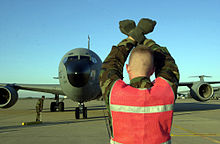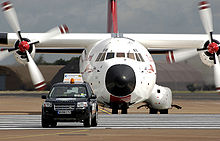- Aircraft marshalling
-
 A long exposure of a United States Navy Culinary Specialist directing a SH-60F Oceanhawk to take off using marshalling wands
A long exposure of a United States Navy Culinary Specialist directing a SH-60F Oceanhawk to take off using marshalling wands
Aircraft marshalling is visual signalling between ground personnel and pilots on an airport, aircraft carrier or helipad. [Image:Marshalling Signals.gif] Marshalling is one-on-one visual communication and a part of aircraft ground handling. It may be as an alternative to, or additional to, radio communications between the aircraft and air traffic control, The usual equipment of a marshaller is a reflecting safety vest, a helmet with acoustic earmuffs, and gloves or marshalling wands, handheld illuminated beacons.
At airports, the marshaller signals the pilot to keep turning, slow down, stop, and shut down engines, leading the aircraft to its parking stand or to the runway. Sometimes, the marshaller indicates directions to the pilot by driving a "Follow-Me" car (usually a yellow van or pick-up truck with a checkerboard pattern) prior to disembarking and resuming signalling. This, however, is not an industry standard.
At busier and better equipped airports, marshallers are replaced on some stands with a Visual Docking Guidance System (VDGS), of which there are many types.
On aircraft carriers or helipads, marshallers give take-off and landing clearances to aircraft and helicopters, where the very limited space and time between take-offs and landings makes radio communications a difficult alternative.
Contents
ICAO aircraft marshalling signals
http://www.langleyflyingschool.com/Pages/CPGS%20Flight%20Operations.html-
Insert chocks
Helicopter marshalling signals
References
External links
- UK marshalling signals, airfield markings and lighting standards.PDF (1.82 MB), from the CAA.
Categories:- Aviation terminology stubs
- Aviation terminology
Wikimedia Foundation. 2010.





















